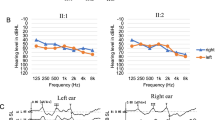Abstract
With a prevalence of 0.1 %, hearing loss is among the most common sensory impairments and affects several million people around the world. Identification of deafness-related genes or loci may facilitate basic research and clinical translational research of the disorder. The PTPRQ gene encodes protein tyrosine phosphatase receptor Q, which is required for the formation of shaft connectors and the normal maturation and development of hair bundles in the mammalian cochlea. Here, we present the genetic and molecular characteristics of a Kazakh family with an autosomal recessive non-syndromic hearing impairment, DFNB84. Using whole-exome sequencing, we identified two mutations that together form a novel compound heterozygous mutation in PTPRQ. Sanger sequencing confirmed that the affected members inherited both the c.16_17insT (L8fsX18) and c.2714delA (E909fsX922) mutations. Both mutations lead to a frameshift and a truncated form of the protein. The novel compound heterozygous mutation co-segregated with hearing loss in this family, and neither of the two mutations was found in 200 healthy Kazakh controls or in any of the public databases. In the study, we identified novel mutations in PTPRQ responsible for DFNB84. This is the third report of PTPRQ mutations involved in deafness and the first report of familial deafness in China. The identification of novel mutations in PTPRQ presented here further confirms the essential role of PTPRQ in hearing development and auditory function. Our data provide additional molecular information for establishing a better genotype–phenotype understanding of DFNB84.


Similar content being viewed by others
References
Goodyear RJ, Legan PK, Wright MB, Marcotti W, Oganesian A, Coats SA, Booth CJ, Kros CJ, Seifert RA, Bowen-Pope DF, Richardson GP (2003) A receptor-like inositol lipid phosphatase is required for the maturation of developing cochlear hair bundles. J Neurosci 23:9208–9219
Goodyear RJ, Jones SM, Sharifi L, Forge A, Richardson GP (2012) Hair bundle defects and loss of function in the vestibular end organs of mice lacking the receptor-like inositol lipid phosphatase PTPRQ. J Neurosci 32:2762–2772
Li H, Durbin R (2010) Fast and accurate long-read alignment with Burrows-Wheeler transform. Bioinformatics 26:589–595
Li R, Yu C, Li Y, Lam TW, Yiu SM, Kristiansen K, Wang J (2009a) SOAP2: an improved ultrafast tool for short read alignment. Bioinformatics 25:1966–1967
Li R, Li Y, Fang X, Yang H, Wang J, Kristiansen K, Wang J (2009b) SNP detection for massively parallel whole-genome resequencing. Genome Res 19:1124–1132
McKenna A, Hanna M, Banks E, Sivachenko A, Cibulskis K, Kernytsky A, Garimella K, Altshuler D, Gabriel S, Daly M, DePristo MA (2010) The genome analysis toolkit: a MapReduce framework for analyzing next-generation DNA sequencing data. Genome Res 20:1297–1303
Mehl AL, Thomson V (1998) Newborn hearing screening: the great omission. Pediatrics 101:E4
Mehl AL, Thomson V (2002) The Colorado newborn hearing screening project, 1992-1999: on the threshold of effective population-based universal newborn hearing screening. Pediatrics 109:E7
Morton NE (1991) epidemiology of hearing impairment. Ann N Y Acad Sci 630:16–31
Oganesian A, Poot M, Daum G, Coats SA, Wright MB, Seifert RA, Bowen-Pope DF (2003) Protein tyrosine phosphatase RQ is a phosphatidylinositol phosphatase that can regulate cell survival and proliferation. Proc Natl Acad Sci USA 100:7563–7568
Sakaguchi H, Tokita J, Naoz M, Bowen-Pope D, Gov NS, Kachar B (2008) Dynamic compartmentalization of protein tyrosine phosphatase receptor Q at the proximal end of stereocilia: implication of myosin VI-based transport. Cell Motil Cytoskelet 65:528–538
Santos-Cortez RL, Lee K, Azeem Z, Antonellis PJ, Pollock LM, Khan S, Irfanullah, Andrade-Elizondo PB, Chiu I, Adams MD, Basit S, Smith JD, Nickerson DA, McDermott BM Jr, Ahmad W, Leal SM (2013) Mutations in KARS, encoding lysyl-tRNA synthetase, cause autosomal-recessive non-syndromic hearing impairment DFNB89. Am J Hum Genet 93:132–140
Schneider ME, Belyantseva IA, Azevedo RB, Kachar B (2002) Rapid renewal of auditory hair bundles. Nature 418:837–838
Schraders M, Oostrik J, Huygen PL, Strom TM, van Wijk E, Kunst HP, Hoefsloot LH, Cremers CW, Admiraal RJ, Kremer H (2010) Mutations in PTPRQ are a cause of autosomal-recessive non-syndromic hearing impairment DFNB84 and associated with vestibular dysfunction. Am J Hum Genet 86:604–610
Shahin H, Rahil M, Abu Rayan A, Avraham KB, King MC, Kanaan M, Walsh T (2010) Nonsense mutation of the stereociliar membrane protein gene PTPRQ in human hearing loss DFNB84. J Med Genet 47:643–645
Takenawa T, Itoh T (2001) Phosphoinositides, key molecules for regulation of actin cytoskeletal organization and membrane traffic from the plasma membrane. Biochim Biophys Acta 1533:190–206
Wright MB, Hugo C, Seifert R, Disteche CM, Bowen-Pope DF (1998) Proliferating and migrating mesangial cells responding to injury express a novel receptor protein-tyrosine phosphatase in experimental mesangial proliferative glomerulonephritis. J Biol Chem 273:23929–23937
Acknowledgments
This work was supported by a grant from the National Basic Research Program of China (No. 2011CB504502) and Shanghai Key Scientific Research Program (14DJ1400101).
Conflict of interest
The authors declare no conflicts of interest.
Author information
Authors and Affiliations
Corresponding author
Additional information
Communicated by S. Hohmann.
Q. Sang and H. Mei contributed equally to this work.
Electronic supplementary material
Below is the link to the electronic supplementary material.
438_2014_979_MOESM1_ESM.tif
Supplementary material 1 (TIFF 2025 kb). Supplementary Fig. 1 Conservation analysis shows that the mutant residue in PTPRQ is conserved across some species
Rights and permissions
About this article
Cite this article
Sang, Q., Mei, H., Kuermanhan, A. et al. Identification of a novel compound heterozygous mutation in PTPRQ in a DFNB84 family with prelingual sensorineural hearing impairment. Mol Genet Genomics 290, 1135–1139 (2015). https://doi.org/10.1007/s00438-014-0979-1
Received:
Accepted:
Published:
Issue Date:
DOI: https://doi.org/10.1007/s00438-014-0979-1




